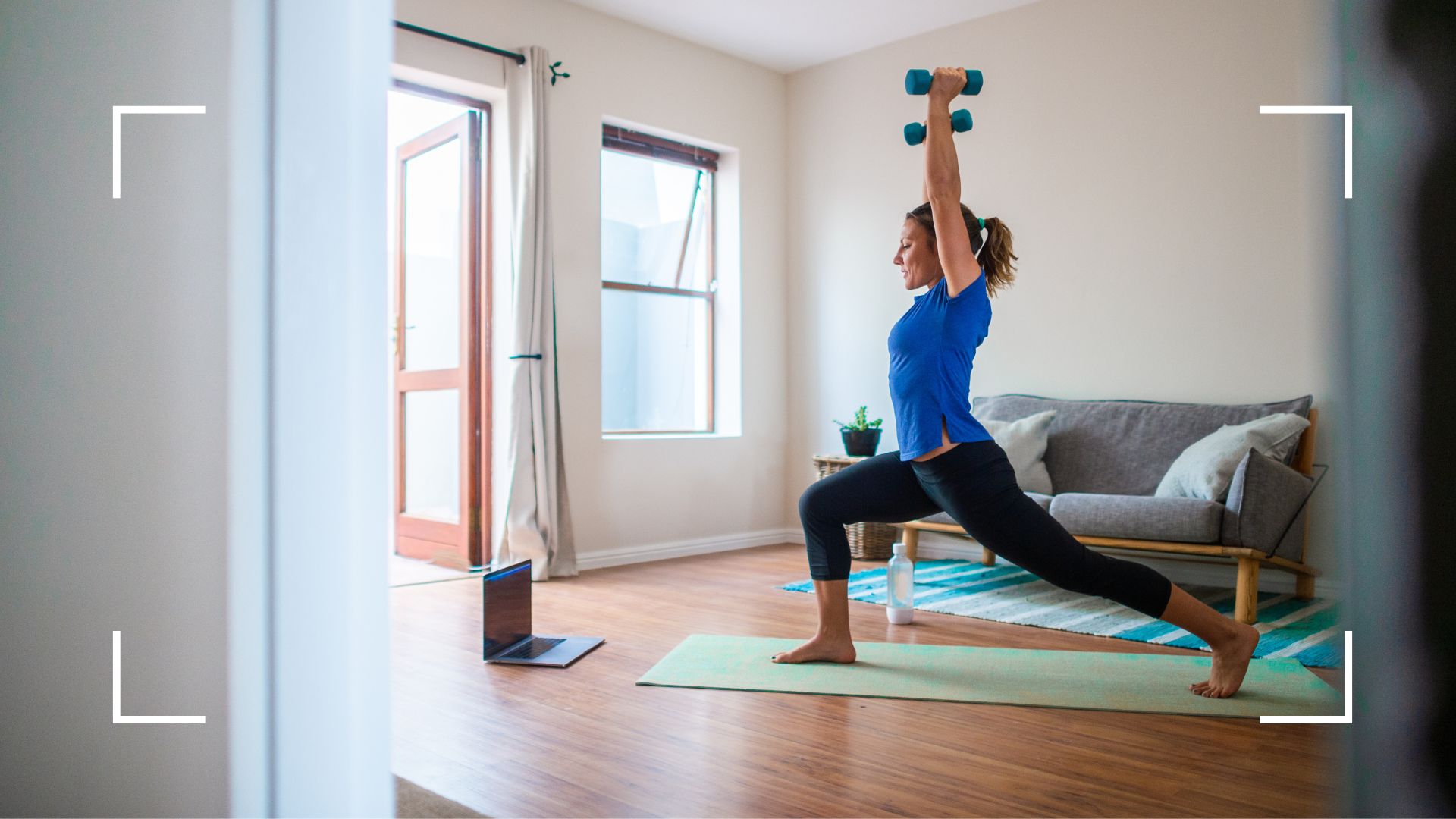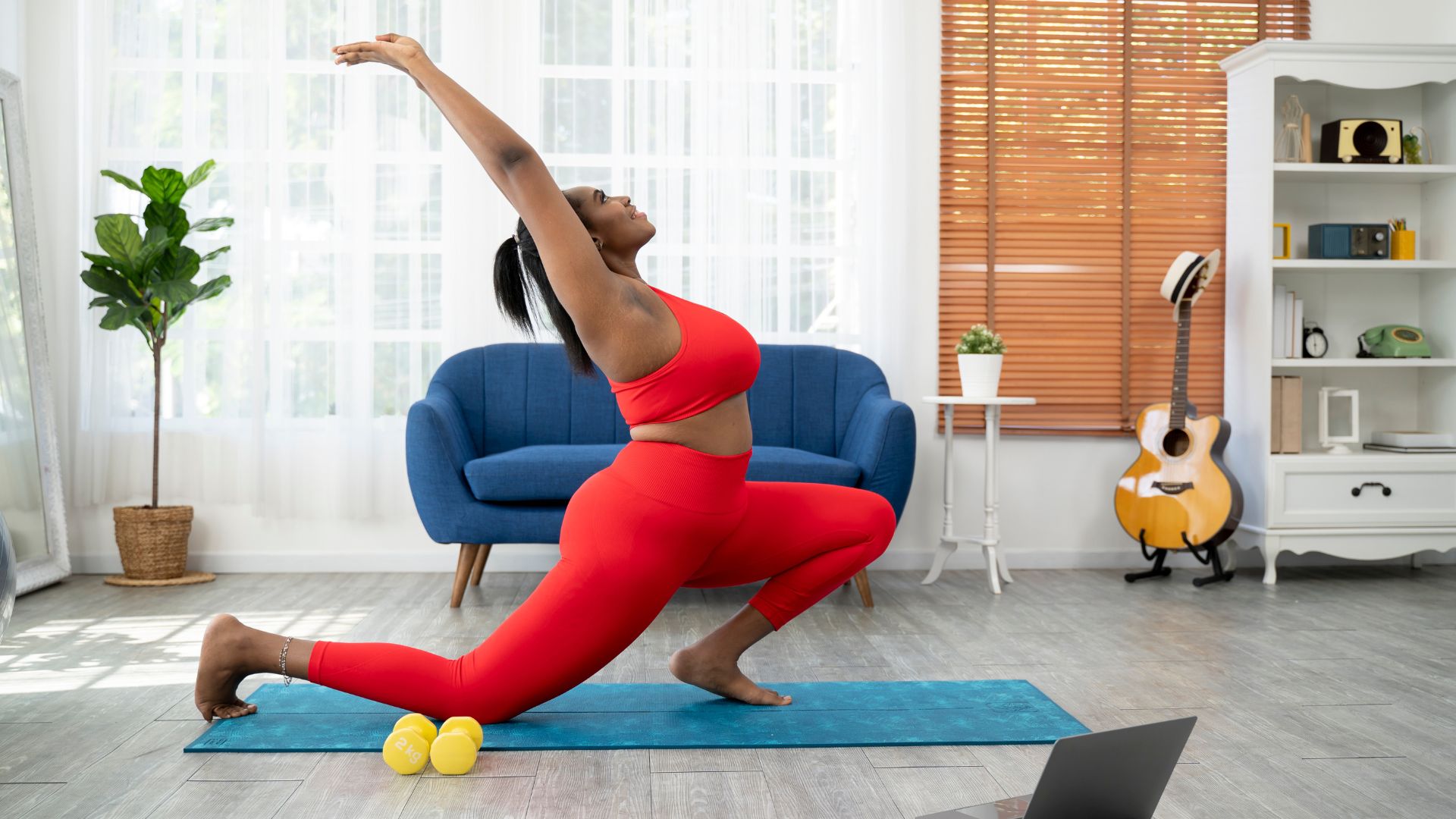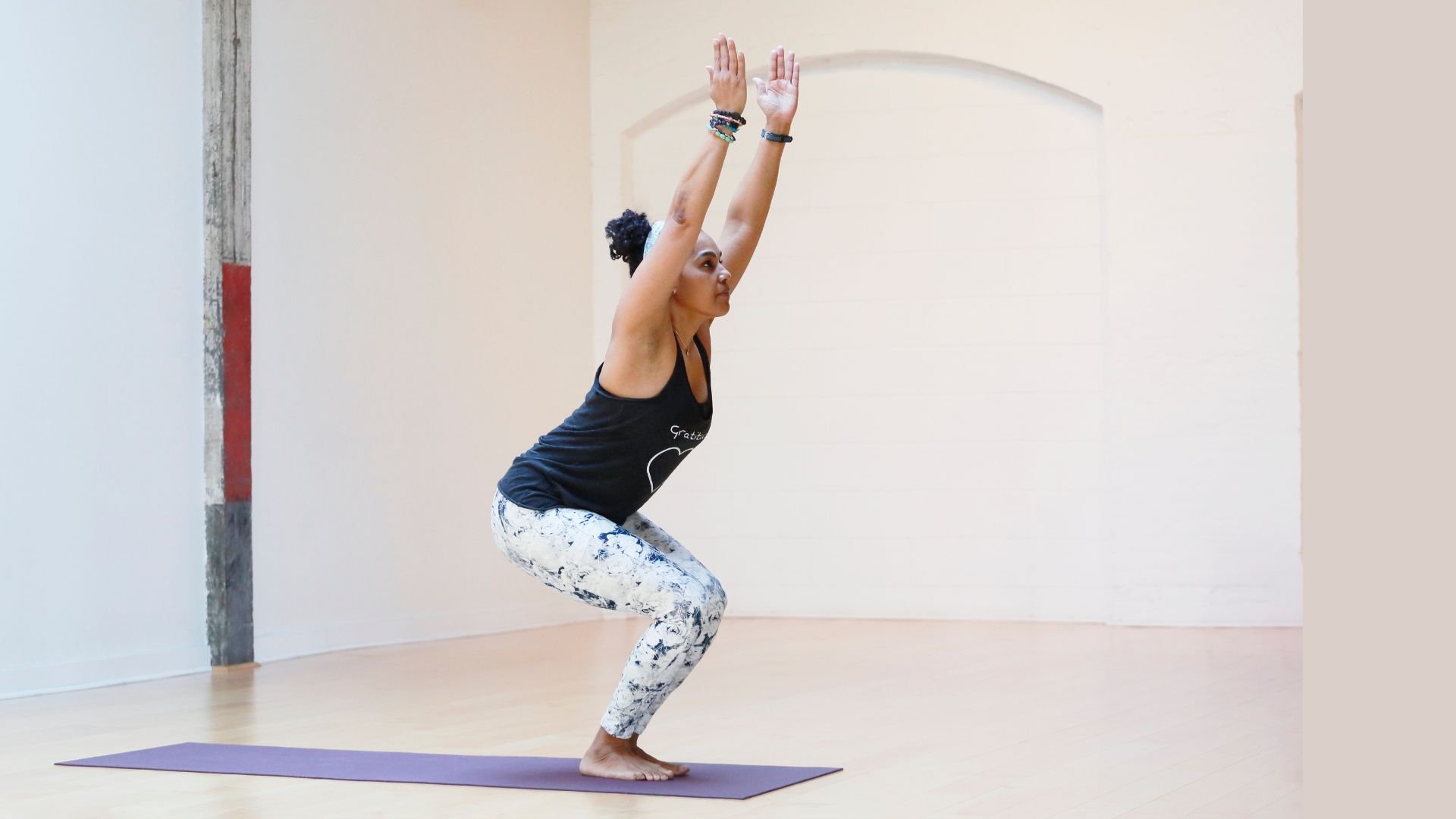How to do yoga as a workout: 7 tips for boosting fitness and strength with the exercise
Doing yoga as a workout can be a great way to boost your fitness. Here, a certified teacher explains what changes your routine needs


Yoga is often thought of as a gentler form of exercise but you can do yoga as a workout too, provided you add in certain higher-intensity elements and focus on engaging your muscles in a productive way.
Most of us are only using our bodies when we perform our regular yoga routine - but what you may not realize is that this offers the perfect chance to increase the intensity of our practice and turn it into a higher-intensity workout. For example, many yoga poses - such as the crow pose - work to strengthen the muscles in the upper body by forcing us to hold our own weight on our shoulders, arms, and back. As you’re holding your body in poses that you have to actively support by engaging your muscles, this is a form of strength training.
The type of yoga you choose to do can also make a difference when it comes to raising your heart rate and pushing your muscles. Those who practice yoga nidra experience a very different session from those doing Ashtanga yoga and yoga for beginners, even though they may be relatively relaxed forms of practice. While both hot yoga and power yoga are much more intense, they are very different from each other.
So if you're looking to increase the intensity of your yoga workout, increase your fitness levels, get stronger, or do some yoga for weight loss, we've got you covered. What constitutes a workout differs from person to person, depending on factors like fitness, age, and ability, so we've spoken to a certified yoga teacher to reveal exactly what changes and/or additions you could make to turn your regular practice into even more of a workout.
How to do yoga as a workout
1. Add in dynamic sequences
The more you move your body, the higher your heart rate will get. If you're looking to work out to improve your cardiovascular health and endurance, incorporating some dynamic movements into your yoga practice will be essential.
This can include adding faster-paced movements between poses. Michelle Polizzi, a certified yoga instructor, says, “You could modify your sun salutation to include a lunge instead of a warrior one, then pulse your legs three times while in the high lunge.”

Lunges engage the quadriceps (thigh muscles), gluteus maximus (buttocks) and the adductor magnus (the muscles on the insides of your thigh).
2. Integrate strength-building poses
Choose yoga poses that target and engage major muscle groups, known as compound exercises. Holding these poses and focusing on proper alignment will help build muscle strength over time.
Sign up to our free daily email for the latest royal and entertainment news, interesting opinion, expert advice on styling and beauty trends, and no-nonsense guides to the health and wellness questions you want answered.
Incorporating some of these poses is a good idea if you're looking to create a higher-intensity, efficient, and effective cardio workout. However, it's important to build strength for other reasons too. As we grow older, one of the main symptoms of perimenopause is muscle loss, which can inhibit movement and flexibility over time. But as a study by the University of Oklahoma shows, after just eight months of yoga, participants can experience serious improvements in leg strength, blood pressure, and heart rate.
Here are three strength-building yoga poses to add to your routine:
- Warrior poses: As pictured above, warrior pose strengthens and stretches the legs and buttocks, hip flexors (the front of your hips), and the tiny muscles that support your shins.
- Plank variations: The classic plank will target your core muscles predominantly, along with your shoulders and lower back.
- Chair pose: Much like squatting, chair pose (as pictured below) engages the entire legs from the buttocks and thighs to the calves and smaller muscles around the ankles.

The chair pose will also help you engage your core muscles.
3. Include high-intensity intervals
Intervals involve periods of high-intensity exercise, followed by lower-intensity exercise. They're great for improving your fitness and can be easily included in a standard yoga practice, just like they are with running and gym workouts.
Integrate bursts of movement like jumping jacks, high knees, and other easy cardio exercises between yoga poses, suggests Polizzi. These intervals elevate your heart rate and boost the cardiovascular benefits of your yoga practice, without forcing you to maintain a consistently high effort.
"Add in some mountain climbers into a plank," suggests the teacher. "Or move from a low lunge into a standing tree position while on one leg, which will also help you get stronger."
Another benefit of incorporating intervals into your yoga practice is that you can start doing yoga as a workout without having to increase the time spent on the mat. These bursts of movement force you to push yourself more in a limited amount of time.
3. Try power or Vinyasa yoga
Power yoga and Vinyasa classes often involve a faster-paced flow, which incorporates both strength and cardio elements. These styles can provide a more intense workout compared to slower-paced yoga classes, as noted.
Tony Horton, a certified personal trainer, says these are programs he personally recommends clients incorporate into their programs. "Combine a seamless Vinyasa flow with high heart rate movements like high-rep leg, ab, and core movements. A higher-paced power yoga sequence intertwined with the Vinyasa style will certainly get the heart rate up and burn more calories," he says.
4. Add in some light weights
As much as we use our own body weight during yoga for resistance, you could also add in some wrist or ankle weights to increase the intensity. The more resistance you put against yourself, the harder your body has to work to overcome it, the more energy you use, and the more calories you burn.
There are some movements in yoga you could easily add weights to, such as a goddess pose with bicep curls, a bridge pose with a chest press, or a warrior pose with weighted shoulder taps, turning even the most relaxing yoga practice into a strength training workout.
To build up the intensity even further, try doing higher repetitions with the weight (between 15 to 20 reps). Not only will this help to get your heart rate up, but it'll also help build muscle as you put your body under a significant stressor for a longer amount of time through the same workout.

5. Hold the poses
Even the gentlest yoga routine can be challenging if you're not used to holding poses for an extended length of time. It's one of the reasons why Pilates for strength training is such a popular workout. To practice yoga as a workout, really hold those poses for as long as you can and you’ll soon see how much strength it requires.
As yoga is a complete mind and body workout, you’ll also be using meditation techniques and breathwork to help hold these poses for longer and longer each time.
6. Repeat the poses
One of the ways we can improve our fitness and grow muscle is by doing the same yoga pose repeatedly until our body becomes fatigued. As research from Universidad Isabel I explains, as we fatigue our muscles through a set of repetitions (or during a yoga pose), pushing them until failure, we recruit more of the muscle in that area of the body at a higher intensity. This is essential if you're looking to grow muscle or maintain it.
You’ll soon be able to feel which poses are working your muscles more than others, so check in during your workout to see which ones feel the hardest. When you’ve identified which these poses are for you, repeat them a few times.
How long do you have to do yoga for?
If you're new to yoga, sessions should start off gently and be around 15 minutes long each time. However, as with all types of workouts, it's different for every person. "You'll feel the positive mental impact of yoga in the first ten to 15 minutes," says Horton, who is also the founder of the successful P90X fitness program. “But it's difficult to say that there's a specific amount of time you'll need to acquire all the benefits of yoga in your workout. It’s nuanced and specific to the individual, so it's impossible to make a blanket statement about how long your workout should be."
As a middle ground for beginners, he says, "a well-paced half-an-hour will certainly count as an effective workout." Then as you become more familiar and proficient at the type of yoga you're doing, "you'll need to lengthen your yoga routine to 60 or 90 minutes" to see substantial changes.
Polizzi also notes that it's not just about the length of time you practice per session but how often you practice. "Yoga would count as a workout at 30 minutes of relatively fast-paced movement. At least three times a week would help you see results, but four or five times a week would help you see results more quickly." Wondering how many times a week you should practice for your goals? Take a look at our guide on how often you should do yoga.
Can you do yoga as your only exercise?
Yes, doing any form of exercise is better than doing none at all and, as Polizzi says, "Yoga could be your only form of strength training because there are many types of yoga, and you could add weights, add speed, or slow it down."
It also depends, as noted, on your age and fitness age, level, and what you want to achieve as to whether yoga just by itself will benefit you. For example, if you're looking to strengthen your upper body and core then research featured in a review from the University of Mississippi suggests this is more than enough. The report found that "yogic practices enhance muscular strength and body flexibility, promote and improve respiratory and cardiovascular function".
However, it's important to have some variety in your routine. "Doing the same exact type of yoga every day would add too much repetition to the same muscles while ignoring other areas, and our bodies crave variety," says Polizzi. "I also wouldn’t recommend doing yoga alone by itself because I think getting outside and moving is important for mental and physical health and enables a well-rounded wellness routine."
So, you could try learning how to start running as a beginner, increasing the amount of high-intensity cardio exercise you do outdoors. Or for something lower-impact, try walking or swimming as a workout alongside your regular yoga practice.
Is 20 minutes of yoga a day enough exercise?
If you're pushed for time, 20 minutes of yoga every day can be enough. But if you're looking to do yoga as a workout, you'll probably need to aim for more than that.
As Polizzi explains, “Twenty minutes of yoga per day could be enough exercise for certain days, but it isn’t enough overall. Keep in mind that the Center for Disease Control recommends 30 minutes of moderate exercise a day at least five times per week, along with two days of strength training, so this is a good rule to follow.”
Samantha is a freelance writer from Yorkshire, writing about health and wellbeing for Woman & Home, Reader's Digest, Giddy, and Good Housekeeping. For the past 15 years, she's combined her personal experiences with reporting, to write about menopause, fitness, sleep, and healthy eating. She also writes about travel and food and drink for The Independent, The Good food Guide, Lonely Planet, Frommer's, and more.
